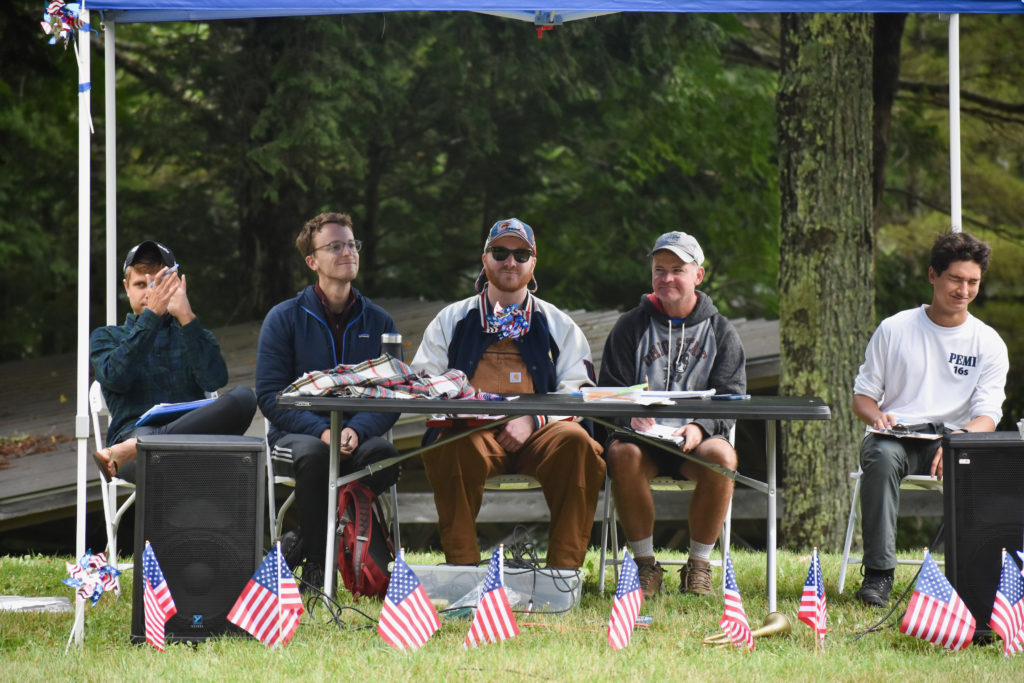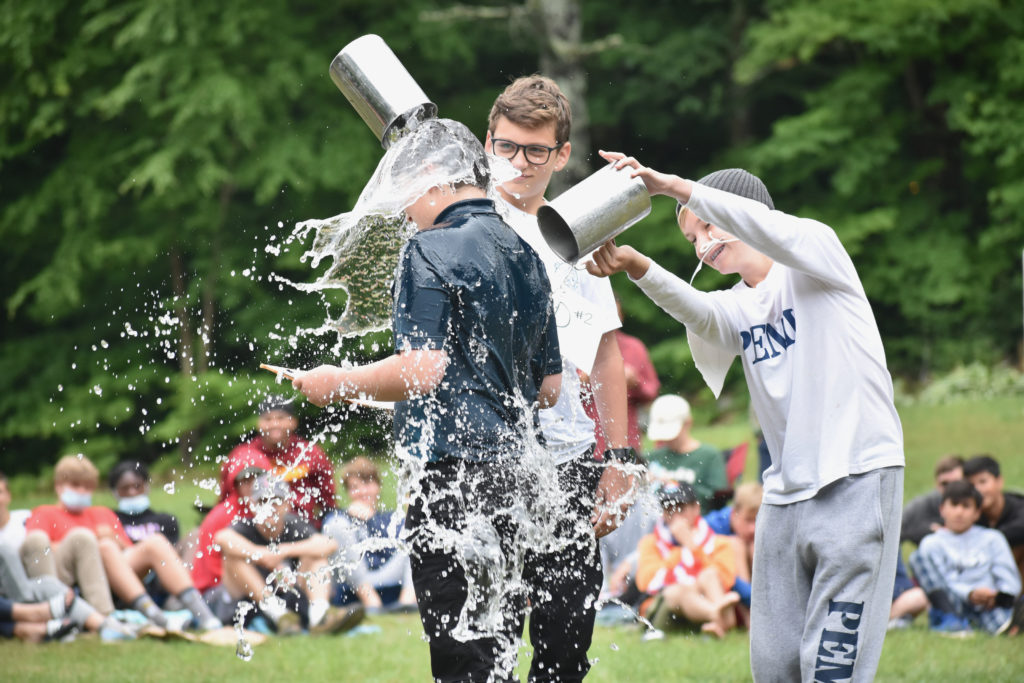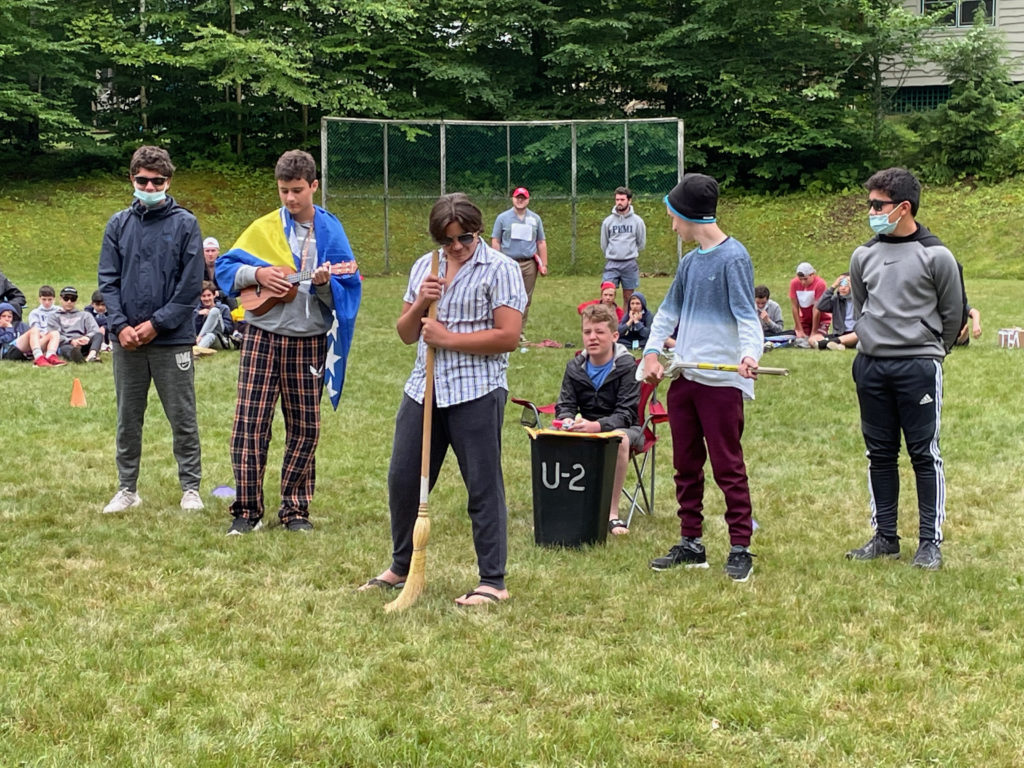- Camp Pemigewassett
- Newsletters 2021
- Pemi History
Camp Traditions: Fourth of July
Camp Pemigewassett Newsletter # 2 (2021)

There were a few times in the past week when we might have been forgiven for thinking we were out on the heath with King Lear, aptly remarking that “the rain it raineth every day.” Nevertheless, spirits have remained high, even as the occasional thunderstorm rumbled its bellyful—largely owing to the energy and enthusiasm of this year’s remarkable staff. Also buoying was the news on Wednesday that Pemi passed its Day 5 Lucira COVID tests with zero positive results! As a result, cohorts have expanded, and the boys have chosen this week’s activities on more of an individual basis. In between the cloud banks, Head of Trips Sam Papel has managed to send day trips up nearby Mt. Cube and Rattlesnake Mountain, overnights up to the Adirondack-style shelter on Pemi Hill, and (today) a day hike up Mount Moosilauke. Joining Trip Leaders Alice Riley and Thaddeus Howe on this imposing 4800-footer, the most majestic stand-alone peak this side of Katahdin, are Seniors Jon Ciglar, Victor Campanile, Luke Wirin, Augie Tanzosh, Will Hood, Matteo Littman, Davis Bachman, Stefan Leudtke, Billy Murnighan, Boone Snyder, Andrew Muffett, and William Webber. They’re sure to have a strenuous but rewarding day.
Pemi celebrated the Fourth of July in its customary grand style, with the annual Parade (that’s “Pee-rade” in local parlance), Counselor Hunt, Vaudeville, and Fireworks Display. In this historic season—the first in which Pemi has ever re-started after a year’s hiatus—we thought it might be fun to look briefly at the history of all four of these hallmark Fourth events, as in when they started and how they have evolved (as witnessed by your humble septuagenarian correspondent.) We offer them in no particular chronological order (mainly to help out with a thematic segue, which we hope you catch!)
The Pee-rade
Visions of Macy’s Thanksgiving Parade are of limited use in imagining the Pemi Pee-rade. There has never in our memory been a helium-filled mock-up of either the Pemi Kid or Metal Boy, and the parade route has never featured any building higher than one story or made of anything other than wood. The custom did, though, start out in the very early years of the twentieth century as an actual parade, with each cabin conjuring up a “float” that would file past the judges’ stand in front of the Senior Lodge, carry on around the tennis courts, and wait patiently for a second pass by the judges to refresh their memories prior to their momentous decisions. Themes then, as now, tended to involve American history, Pemi history, current events, Pemi life with notable characters, and our storied rivalry with Camp Tecumseh—occasionally featuring a post-modern mash-up wherein, say, Chief Tecumseh somehow melds with King George the Third, so that the Pemi colonists thrash both “evil oppressors” at once. The parades were largely silent, acted (if at all) in mime, while the excellent Pemi Silver Cornet Band provided all the Sousa marches one could hope for.
Over the years, the steady passage of floats gave way to some and then most cabins stopping right in front of the judges’ stand to perform a little playlet while the rest of the parade behind them came to a grinding halt. One of the more witty ones that we can remember featured a cabin with a particularly wry and irreverent turn of mind basing their act on the Gospel of Matthew and holding up posterboards in the faces of their evaluators that read “Judge not, lest ye be judged.” The panel, then largely made up of directors’ wives and the wives of other staff, were suitably impressed (or chastened) and awarded the cabin with the standard box of Whitman’s Sampler Candy.
With all the dramatic stopping and starting, steady musical accompaniment by the band made less and less sense, sounding more like a game of musical chairs than anything more august. Besides, the members of what was often a 40-piece brass ensemble never got to see the various floats! So, in the mid ‘Sixties, the live music gave way to recordings, and the musicians either joined their cabinmates in the floats/skits or joined the roadside crowd to enjoy the event as spectators. Once it was granted that even more people might actually enjoy seeing the whole thing (even if they were in it), the trip around the tennis courts and the second pass of the floats gave way to the first cabins through just settling on the grass past the judges’ stand to watch the rest of their peers. What a concept! Entertainment for all, and not just the spouses of various staff members.
The next, big, spectator-friendly switch came in 2017, when a July 1 flood temporarily took out the normal parade route and the event was moved to the Junior soccer field, where a rural equivalent of The Globe was constructed for the various acts. Necessity that year was deemed to be a virtue, and the Pee-rade has been held there ever since. This year’s winners? In the Junior Division, the Lower Juniors (cabins 1-3) with “The Sales Pitch” (touting Pemi in a fake infomercial hawking vacation cabins without heat, screens, or hot tubs); in the Lowers, a tie between L3 (“The Unwritten History of the Pemi Valley,” which ended with the revisionist union of European settlers and indigenous bands in one, big, happy Pemi family) and L7 (whose “Study of American History” somehow involved learned lecturer Benji Edelson having pitchers of water dumped on his head three separate times); in the Uppers, U3 (with “Pemi Moore,” featuring Nick Paris dressed as our beloved director singlehandedly saving Pemi from personified corona viruses); and Lake Tent (wittily reflecting on some of our recent DEI reconsideration of selected mess hall songs by wordlessly humming “Mabel” only to launch into a lusty rendition of “Over There,” lyrics and all!) Kudos to all for their imaginative efforts on the nation’s birthday.
Quick Pee-rade-related random note on the passage of time: Back in the early ‘Sixties, Upper Two not so subtly capitalized on its cabin abbreviation (“U2”) and constructed Francis Gary Powers’s infamous downed spy plane out of a wooden cot and two extended ironing boards. More recent iterations from the same cabin have featured Bono, The Edge, and the other members of the great Irish rock band. To each era their own U2.
The Vaudeville Show

Curiously, as the Pee-rade evolved into a peripatetic theater experiment and its traditional musical accompaniment declined or even vanished, the annual Fourth of July vaudeville show went in the opposite direction. Launched in the very first years of camp, when actual vaudeville shows were as current in the outside world as comedy clubs and concert tours are today (at least in a non-COVID year), Pemi’s vaudevilles occasionally involved performances on piano (toting a Baldwin to the Senior Beach for weekly campfires being out of the question.) But the bulk of the acts were little satiric dramas involving, say, particularly harsh inspection graders or a camp laundry that seemed incapable of cleaning anything without ripping it to shreds or, sometimes, recitations of comic poems from A.A. Mllne or Edward Lear. As the Pee-rade became more frequently dramatic, though, vaudeville became more and more musical, especially as electrified instruments (long impossible to power on the wire-free beach) began to be more and more prevalent on the popular music scene. On this last Fourth, for example, three of the most well-received acts involved guitarist Danny Kerr, keyboardist Jack O’Connor, and bassist Luke Larrabie delivering a superb instrumental version of Stevie Wonder’s “Isn’t She Lovely?”, Jack and Head of Music Michaella Frank covering Maroon 5’s “Sunday Morning,” and Head of Drama Beanie Lawrence, backed by a recorded orchestra, filling the valley with her powerful rendition of the signal aria from Mozart’s The Magic Flute. Although the show was held outside, due to COVID protocols, and there was therefore no way for Beanie to bring down any surrounding house, there was no doubt that she was the Queen of the Night. And so, as the grand Sousa Pee-rade has given way to skits on the move, the vaudeville has picked up the musical torch. Such is the ever-changing steady state at Pemi.
The Counselor Hunt

The less said about the Counselor Hunt, perhaps, the better. The dark custom was inaugurated at Pemi in the ‘Sixties, after your correspondent had stopped being a camper and started being a staff member. He can’t testify, then, to what is undoubtedly the bloodthirsty joy of the campers who, pent up in the Lodge while the counselors have five minutes to hide, have a full ten minutes to hunt them down within the limited area where they are allowed to hide, identify them by name (the counselors’ union having failed to secure an additional identifying requirement of birthdate and Social Security number) , and escort them down to the waterfront for a plunge off the high-dive in whatever they were wearing or concealed by when caught. (This year’s style kudos go to E. J. Burnett, Jack Davini, and Will Raduziner, who were caught in matching black ninja suits with bright yellow swim caps!) Just writing about this evokes for me the primal terror I used to experience as the horn signaled the start of the hunt and, while the footfalls of the searching throngs pounded ever closer, I was sure that the thunderous thumping in my chest would give me away as surely as the old man’s heart in Edgar Allen Poe’s classic story. I was caught as often as not—and usually so covered with mosquito bites that the plunge into the lake was a relief. In any case, the staff seems to tolerate it and the boys seem to like it well enough that the tradition is now approaching its sixtieth anniversary. But talk about a kind and gentle camp swerving into Lord of the Flies territory! You should have heard your sweet and innocent sons, lined up along the shore in a frenzied throng, calling out for their dear counselors to try a belly flop from fifteen feet!
The Fireworks Display
Finally, for the real Fireworks. Pemi, early in the last century, used to conform to national expectations and featured a potent celebratory display of rockets and star bombs set off from a float at the Senior Beach. Then, as sometimes happens, an accidental ignition led to some modest burns on the leg of the staff member in charge, and the custom was shelved for some eighty or ninety years. Only with the Directorship of Danny Kerr and the rise to Head of B&G of Reed Harrigan was that decision reconsidered. Every Fourth for decades, we’d heard and even seen the fireworks from neighboring Camp Moosilauke lighting the sky at the far end of the valley. And every year we heard the campers (staff too!) wishing that we could have our own show. So, after conferring with Kenny and assuring themselves that, with adequate safety measure in place, we could resume the practice after a three-quarter-century hiatus, Danny and Reed effected a trip to the fireworks outlet and came home with an array of incendiaries that must have rivalled New York’s annual July 4th or London’s Guy Fawkes Day displays. (Perhaps we exaggerate just a bit.) Everyone watching from the Senior Beach “oohed” and “aahed” with vigor and sincerity and then meandered back to their cabins for a good night’s sleep. I must confess to feeling immense gratitude that our community could enjoy the special day together and model the collective commitment and understanding that we as a country would do well to move a little closer to as well. That’s all for now. Thanks for letting us share.

–TRJR






































